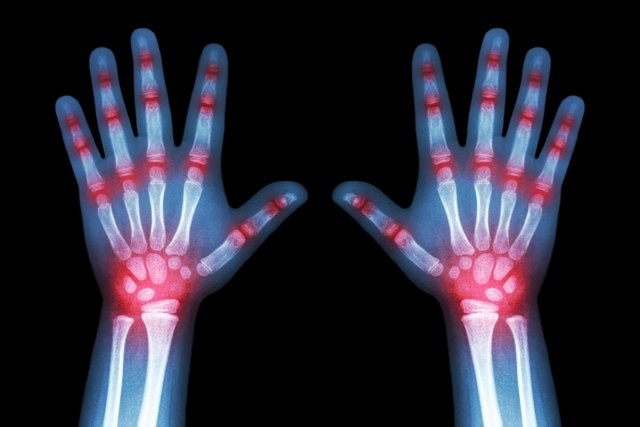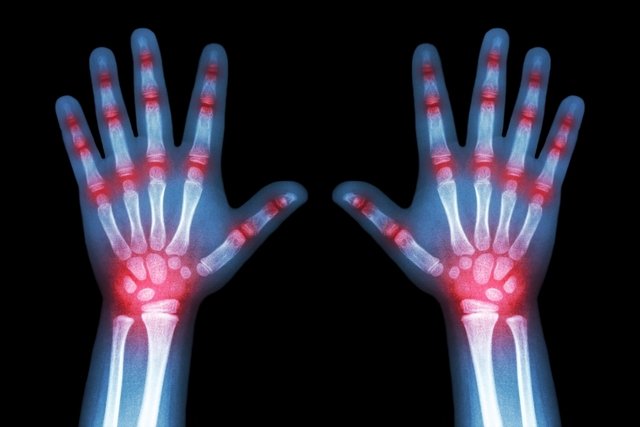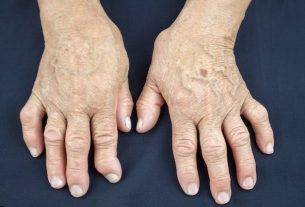Reactive arthritis, formerly also known as Reiter’s Syndrome, is an inflammatory disease that develops shortly after or during a bacterial, usually gastrointestinal, infection. Due to the fact that it occurs as a consequence of an infection, this type of arthritis is called reactive.
Reactive arthritis is composed of the clinical triad: post-infectious arthritis, urethritis and conjunctivitis. This disease is more common in young adults with a history of infection in the last 4 weeks.
In most cases, people diagnosed with reactive arthritis improve after a few months without the need for treatment, however there is a chance it will happen again. Treatment for this type of arthritis is established by the general practitioner or rheumatologist according to the symptoms presented by the patient and the cause of the disease, and the use of anti-inflammatories, analgesics, corticosteroids or antibiotics may be recommended.

Causes of reactive arthritis
Reactive arthritis usually arises as a consequence of a urogenital or intestinal bacterial infection. In the case of urogenital infection, it may be due to sexually transmitted diseases, such as chlamydia, for example, which is caused by the bacteria Chlamydia trachomatis. When due to intestinal infections, it may be due to infection by Campylobacter sp, Shigella sp or Salmonella spfor example.
These infections can occur due to unprotected intimate contact, in the case of Sexually Transmitted Infections (STIs), they can be associated with urethritis or cervicitis, which can be asymptomatic, although in most cases it causes pain and burning when urinating, in addition to urethral or vaginal secretion, or due to food poisoning, in the case of intestinal bacterial infections. Additionally, reactive arthritis can be caused by viral infection. There are also reports of reactive arthritis following immunotherapy for bladder cancer.
Reactive arthritis symptoms
Reactive arthritis is characterized by a triad of symptoms (arthritis, urethritis and conjunctivitis), that is, the disease contains signs of infection, joint inflammation and eye problems. Thus, the main signs and symptoms related to reactive arthritis are:
- Symptoms of infection:
- Polyuria, which is the production of a large amount of urine during the day;
- Pain and burning when urinating;
- Presence of blood in the urine;
- Urgent urge to urinate;
- Signs and symptoms related to prostatitis in men, such as difficulty maintaining an erection, pain when ejaculating and the presence of blood in the semen;
- Signs and symptoms related to cervicitis, salpingitis or vulvovaginitis in women.
- Joint symptomswhich can range from transient monoarthritis to polyarthritis, that is, there may be involvement of one or more joints:
- Joint pain;
- Difficulty moving the affected joint;
- Pain in the lower back;
- Joint swelling;
- Inflammation of the tendons and ligaments associated with the joint.
- Eye symptoms:
- Redness in the eyes;
- Excessive tearing;
- Pain or burning in the bones;
- Swelling;
- Burning eyes;
- Increased sensitivity to light, called photophobia.
In addition, other more general symptoms may also appear, such as excessive tiredness, back pain, fever above 38ºC, weight loss, mouth ulcers, abdominal pain or diarrhea, for example. When these symptoms appear, it is recommended to consult a general practitioner to assess the problem and indicate the need to consult a rheumatologist to begin appropriate treatment.

Diagnosis of reactive arthritis
The diagnosis of reactive arthritis is basically clinical, in which the doctor assesses whether there are signs and symptoms characteristic of the triad, that is, the presence of signs and symptoms related to infection, joint inflammation and eye problems.
In addition, the doctor may request a genetic test to identify HLA-B27, which can be considered a marker that is positive in patients with reactive arthritis. In isolation, HLA-B27 has little diagnostic value and is not indicated in the routine care of these patients.
How the treatment is carried out
Treatment for reactive arthritis is carried out according to the symptoms presented by the person and the cause of the disease, with the rheumatologist normally recommending the use of anti-inflammatory and analgesic medications, such as Paracetamol or Ibuprofen. In some cases, the use of corticosteroids, such as Prednisolone, may also be recommended to reduce inflammation in various parts of the body and alleviate symptoms.
The rheumatologist may also recommend the use of antibiotics if reactive arthritis is caused by a bacterial infection and the body is not capable of eliminating the bacteria, however the use of antibiotics has no impact on the development of the disease. Furthermore, in cases where the joints are affected, physiotherapy may also be indicated, which involves exercises that help to regain movement in the limbs and relieve pain.
However, it is not always possible to completely alleviate all the symptoms of reactive arthritis, resulting in a chronic situation that causes symptoms to recur over a few weeks.
Reactive Arthritis Remedies
In most cases of reactive arthritis, the doctor recommends the use of non-steroidal anti-inflammatory drugs (NSAIDs) to alleviate symptoms, and the use of Ibuprofen or Diclofenac may be recommended to reduce pain and facilitate joint movement. If the use of NSAIDs is not sufficient, the use of other medications may be recommended, such as:
- Corticosteroidssuch as Prednisolone or Betamethasone, to reduce symptoms of inflammation when anti-inflammatories are not sufficient;
- Antibioticswhich varies according to the infectious agent responsible for the infection and the sensitivity profile of the microorganism.
Treatment for reactive arthritis typically lasts about 6 months, but in some cases it can last up to 1 year depending on the severity of symptoms and the person’s response to treatment.
Physical Therapy for Reactive Arthritis
Physiotherapy treatment is important in treating this type of arthritis to prevent joint stiffness. In this way, physiotherapy recommends and performs some exercises to alleviate joint symptoms, increase range of movement and prevent deformities that may occur as a result of the disease.

Sign up for our newsletter and stay up to date with exclusive news
that can transform your routine!
Warning: Undefined array key "title" in /home/storelat/public_html/wp-content/plugins/link-whisper-premium/templates/frontend/related-posts.php on line 12
Warning: Undefined array key "title_tag" in /home/storelat/public_html/wp-content/plugins/link-whisper-premium/templates/frontend/related-posts.php on line 13




